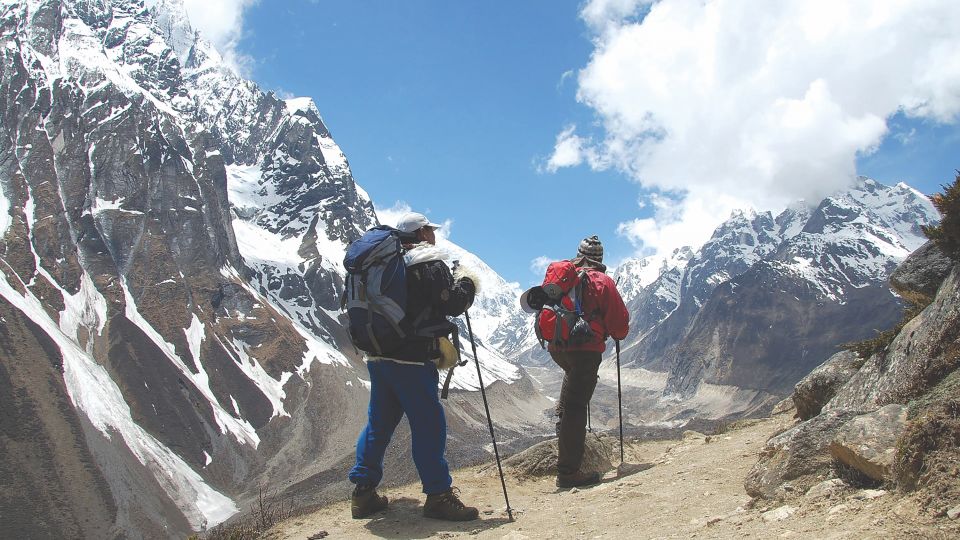
n 1950, French mountaineers Maurice Herzog and Louis Lachenal climbed Annapurna I, the first ever eight-thousander peak to be climbed.
The French team walked down to the Indian border, took a train to Raxaul, re-entered Nepal and trekked up to Kathmandu to be felicitated by Prime Minister Mohan Shamsher Rana.
After being closed to foreigners for centuries, Nepal opened up to the world for the first time. Three years later in 1953, Tenzing Norgay Sherpa and Edmund Hillary catapulted Nepal and the Himalaya into the global limelight.
But more than 70 years later, Nepal’s tourism sector has yet to take full advantage of the economic opportunities that the industry can provide for domestic job creation, production of local products and foreign exchange income.
That Nepal’s tourism has not lived up to its potential to become the backbone of the country’s economy while it grows exponentially in the rest of the world — including in other mountain countries — proves that there are a lot of missed opportunities.
Summing up summits
Visitors flock to Nepal for culture, wildlife and pilgrimage, but our unique selling points are the world’s highest mountains. Some 16% of tourists who visit Nepal come for trekking and climbing, and yet mountaineering opportunities have been woefully under-advertised.
In fact, when Mt Everest does get into the international media, it is either for the ‘traffic jams’ on the summit or as the mountain of garbage. Lately, it is for how global climate breakdown is melting its glaciers. Apart from eight out of the 14 eight-thousanders in the world which are in Nepal, there are 326 mountains above 5,500m that are open for climbing in the country.
Records show that in 1964, only 9,526 tourists entered Nepal, rising to 500,000 two decades later. But it took another 34 years for it to double and exceed 1 million in 2018.
In comparison, 40 million tourists visited the relatively more isolated Tibetan region of China in 2018. Even Bhutan, which is four times smaller than Nepal in area, and has only 700,000 population, has priced itself on the higher side and got 315,000 tourists. Cambodia welcomes more than 6 million tourists annually, promoting its main attraction: the Angkor Wat temple complex.
“2022 did not go as expected,” says Deepak Raj Joshi, former CEO of Nepal Tourism Board. “But 2023 can be much better because Nepal is a nature-based destination, has isolation-based activities – exactly what most people are looking for post-Covid.”
Read also: Visit Nepal Again, Ashish Dakal
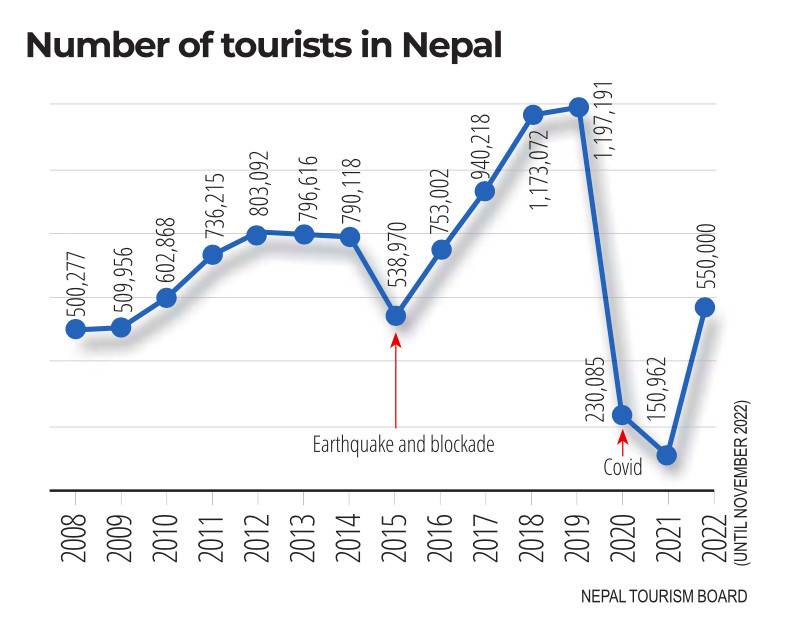
Nepal launched its Visit Nepal 2020 campaign just as Covid-19 struck. Nepal Airlines jets still have its logo on their fuselage, and it is a reminder of a failed drive. Tourism is beginning to pick up again after a two-year slump, but the prospects for 2023 are not so sure.
Even if the numbers pick up again, Nepal will not benefit as much as it should since it is selling itself too cheap. The tourist to Nepal spends an average of only $48 a day. Bhutan with its ‘high cost, low impact’ model, requires its tourists to spend $200-$250 per day in fees.
Despite the unique ‘product’ that Nepal has in its mountains, wildlife and heritage, the country is just not benefiting as it should from the tourism industry which now contributes less than 2% to the national economy.
In 2019, before the Covid-19 pandemic, income from the tourism sector was Rs60.8 billion, which made up only 4.6% of the country’s total foreign exchange earnings.
Tourism’s contribution to Nepal’s hard currency income reached its peak way back in 1981, when it made up 36.8%, up from 30.2% in 1965.
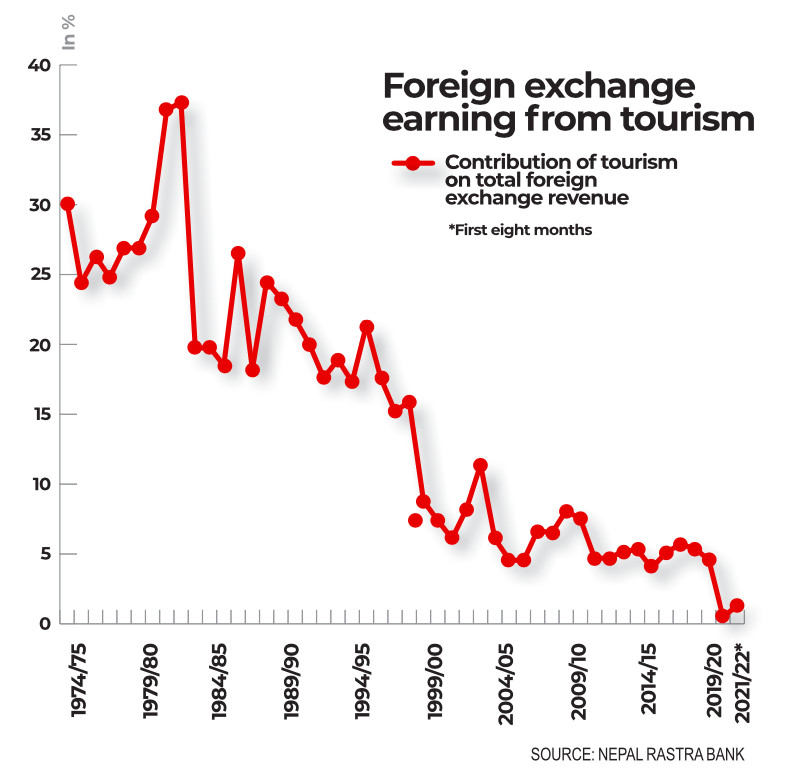
At the time, Nepalis seeking to go abroad for work or studies benefited greatly from being able to exchange dollars for rupees before they left. Ironically, by the 1990s as more and more Nepalis pursued foreign employment their remittance replaced tourism as the major contributor to Nepal’s economy.
Now, money that Nepalis abroad send home makes up two-thirds of the country’s total foreign exchange income, while tourism, exports, foreign investment and development assistance, combined, contribute only one-third. Taking the annual average from 2010-2020, the tourism sector on its own made up only 5.2% of Nepal’s foreign exchange reserves.
This is not to say that tourism has not contributed to the economies of localities within Nepal. The Khumbu region, for example has an annual per capita income more than five times higher than the national average. Trekking has transformed the economies of Langtang, Manang and Mustang, where locals previously depended almost entirely on agriculture or pastoralism.
Indeed, the trekking and mountaineering sectors employ more than 18,000 guides, 50,000 porters and other service providers. In 2018, more than 8,000 mountaineers paid over Rs680 million in climbing fees and created jobs for more than 1,700 Nepali high altitude guides, who are now also hired by expeditions on mountains abroad.
Before Covid, tourism was estimated to provide direct jobs for about 1 million Nepalis and indirectly benefit many more. But industry experts say that the potential for economic benefits should have been much higher.
Read also: Peak climbing season in Nepal, Nepali Times
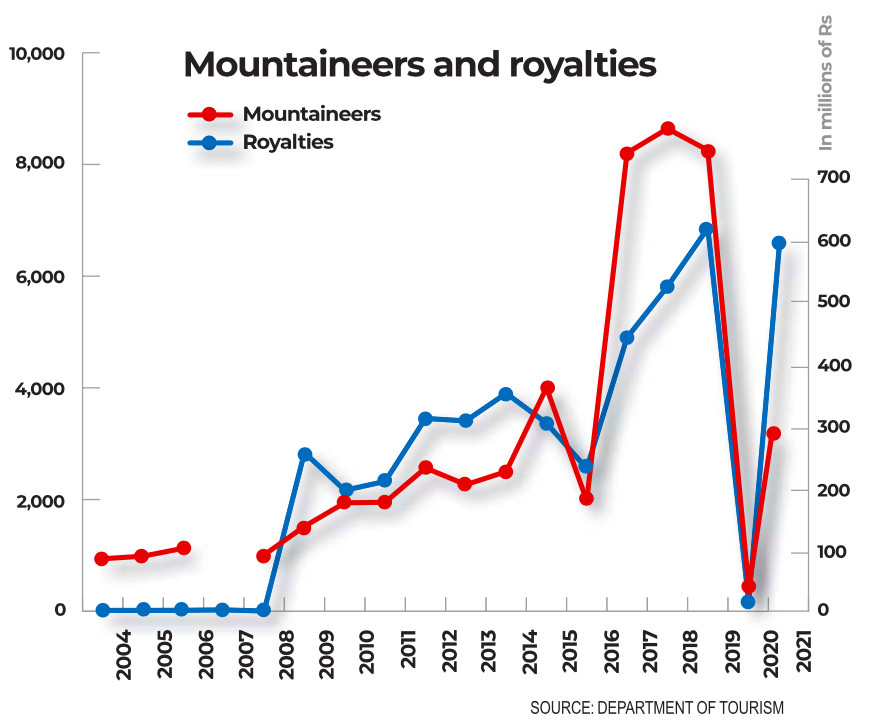
Climbing numbers
Tourism in Nepal has been impacted by major historical events in recent times: the decade-long insurgency from 1996-2006 and subsequent political instability hit arrivals hard. Mountaineers had just returned to Mt Everest after a deadly avalanche in 2014 at Base Camp killed 16, when the earthquake struck one year later.
It was only in 2018 that Nepal was finally able to exceed its target of bringing 1 million tourists, and planners aimed higher to double it with the 2020 campaign.
Nepal spent $2 million dollars in the run-up to the Visit Nepal 2020 campaign. Much of that money was wasted, most Nepalis who lost their jobs migrated overseas for work, many hospitality sector businesses closed down, and hotel projects were abandoned.
Nepal did reap benefits from free promotion by films about mountaineering, including Nims Purja’s 14 Peaks, on streaming services like Netflix, when people were locked down worldwide during Covid.
In 2021, as Nepal confronted a deadly second wave of the virus, foreign visitors dropped to 150,962. The biggest drop was in Chinese arrivals, who were starting to top the list of tourists.
But in 2022, pent-up demand and post-Covid rebound has meant that the numbers were beginning to climb again — when Russia invaded Ukraine in February.
The war has hit the incomes of source countries in Europe and Asia hard, and Nepal’s own economy has gone into a slump. At a time when tourism income could supplant depleted foreign exchange reserves and falling exports, the industry was again adversely affected.
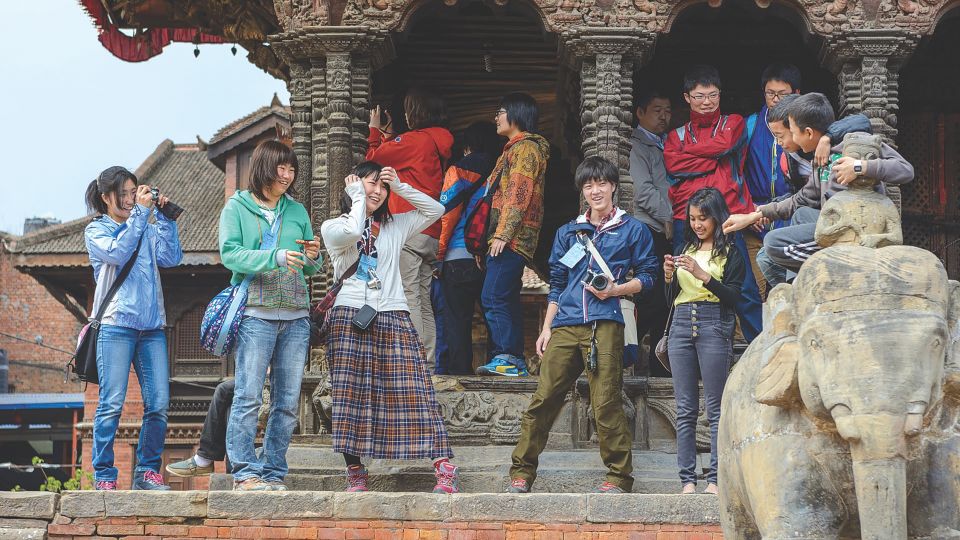
But there was an uptick of arrivals in 2022. Numbers for January-November 2022 reached nearly 550,000, filling up hotels in Kathmandu and Pokhara with most running at near-full occupancy during Dasain. Still, experts argue that Nepal has not been able to build enough of a portfolio in the world market as a tourist destination. Besides, the Kathmandu gateway is getting bad publicity from bloggers and influencers because of its chaos and air pollution.
“We have struggled to build a brand as a tourist country globally because of the lack of necessary tourism infrastructure inside the country,” says tourism entrepreneur Basanta Mishra. “This means our adventure tourism destinations are overshadowed by other global tourist attractions.”
Nepal has been diversifying its adventure tourism brand from just trekking and mountaineering to white water rafting, bungee jumping, paragliding, ziplines, canyoning and other sports. But sustaining adventure tourism will be a tall order in the absence of proper infrastructure or promotion in the global market.
“Nepal has never looked into its full potential as a tourism destination beyond the mountains,” says Suraj Vaidya who led the Visit Nepal 2020 campaign. “Even with mountain tourism, we have failed to look beyond EBC and ABC, when the far-western mountains have so much to offer.”
“We have to also look beyond Kathmandu, Patan and Bhaktapur. We need to look at Nepal as more than a two-season destination,” adds Vaidya. “But at the same time, we need to be careful about how we choose to develop destinations with historic significance so that we preserve and maintain the heritage that is so inherently ours.”
The good news is that Nepal is seeing improvements in tourism infrastructure over the years, especially in the hospitality sector. In recent years, more than a dozen ‘star’ hotels as well as multinational hotel chains have opened up in Nepal, with more under construction. And although new international airports have opened in Pokhara and Bhairahawa, poor planning has meant that there is almost no prospect of international flights from there. Meanwhile, it can take up to 9 hours to drive from Kathmandu to Pokhara because of congestion and poor roads.
But above all, Nepal’s tourism sector has not been a priority for planners even though they have never tired of giving speeches about its potential for decades.
“Being the only European airline flying to Kathmandu, we hope to surpass 2022 figures,” says Serkan Basar, General Manager of Turkish Airlines Kathmandu. “Tourism Ministry and private sector should be in full cooperation for the betterment of the country as a tourist destination.”
Joshi agrees: “Tourism cannot develop in isolation. There needs to be multi-level coordination between tourism institutions, concerned ministries, as well as diplomatic missions across the world to effectively maximise our tourism potential.”
Should Nepal promote high-end tourism rather than just chase numbers of arrivals? There has been no discussion on carrying capacity for various trekking areas and mountaineering peaks.
Given its topography, location and culture, Nepal should be able to sell itself. Still, promotion has been sloppy, ad hoc and inadequate — especially to China and India which are already replacing arrivals from Europe and the Americas.
Says tourism analyst Rajiv Dahal: “Nepal’s policymakers do not yet understand that reviving the tourism sector is in the country’s best interest, and that tourism will not gain momentum unless its potential is fully explored.”












